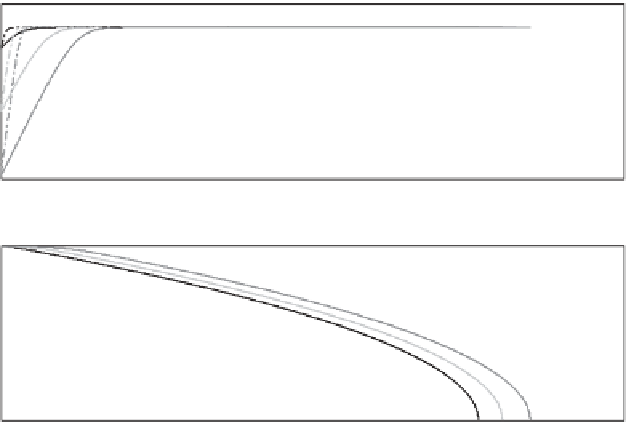Environmental Engineering Reference
In-Depth Information
20 K, one obtains t
d
= 0.054 s.
b. Solving the droplet temperature equation
When the droplet and air temperatures change with time, an explicit analytic
solution in general is not available, but a numerical solution can be obtained.
By solving the aforementioned equations until
For T
s
=T
boil
−
the droplet diameter
reaches 0, we can obtain the droplet lifetime.
s
−1
,
For T
s,i
=T
boil
−
20 = 331 K, v
s
=10m
the droplet
lifetime t
d
=
0.0204 s, and for
T
s,i
=T
boil
−
s
−1
, the droplet lifetime t
d
= 0.0209 s.
A detailed study of this model and a sensitivity analysis of the results are
presented as project at the end of this chapter. Results of such a project may
look as depicted in Figures 4.1 and 4.2.
10 = 341 K, v
s
=10m
Due to the balance between heating and heat extraction for evaporation, liquid dro-
plets usually do not reach the boiling point when they are heated. Instead, the temper-
ature evolves toward the wet-bulb temperature. An estimation of the wet-bulb
temperature can be obtained by setting the left-hand side of Equation (4.44) to zero.
When droplets are situated in a very hot carrier gas, they will reach the wet-bulb
350
340
320
300
0
5
10
Time (ms)
300
0
10
20
30
40
50
Time (ms)
100
50
0
0
10
20
30
40
50
Time (ms)
FIGURE 4.1
Droplet temperature and diameter versus time at a slip velocity between droplet
and gas, v
s
of 0 m
s
−1
. Initial droplet temperatures: 301 K (dark gray), 321 K (light gray), and
341 K (black). Initial droplet diameters: 100
μ
m (solid lines) and 50
μ
m (dashed) lines
(surrounding gas temperature T
b
= 800 K).



























































Search WWH ::

Custom Search